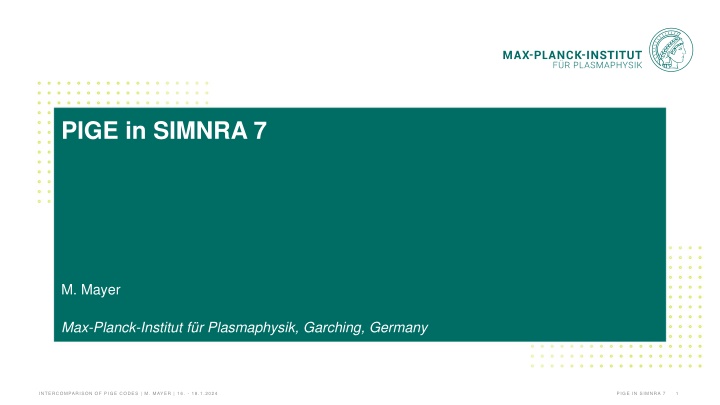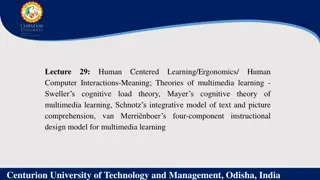
Intercomparison of PIGE Codes and Simulation of IBA Spectra
Discover the intercomparison of PIGE codes and the simulation of IBA spectra, including Monte-Carlo simulation details, analytical codes comparison, RBS/NRA/ERDA processes, and input data considerations. Explore the complexities and efficiencies in simulating ion beam analysis techniques.
Download Presentation

Please find below an Image/Link to download the presentation.
The content on the website is provided AS IS for your information and personal use only. It may not be sold, licensed, or shared on other websites without obtaining consent from the author. If you encounter any issues during the download, it is possible that the publisher has removed the file from their server.
You are allowed to download the files provided on this website for personal or commercial use, subject to the condition that they are used lawfully. All files are the property of their respective owners.
The content on the website is provided AS IS for your information and personal use only. It may not be sold, licensed, or shared on other websites without obtaining consent from the author.
E N D
Presentation Transcript
PIGE in SIMNRA 7 M. Mayer Max-Planck-Institut f r Plasmaphysik, Garching, Germany INTERCOMPARISON OF PIGE CODES | M. MAYER | 16. - 18.1.2024 PIGE IN SIMNRA 7 1
Introduction: Simulation of IBA spectra Monte-Carlo simulation: SRIM, CORTEO, MCERD, GEANT, Trajectories of individual particles High level of detail: Multiple scattering, geometry, Long computing times Computing time improvements introduce additional problems Analytical codes: SIMNRA, RUMP, NDF, Energy distributions of ensembles of particles Trajectories approximated as straight lines + corrections: energy spread by multiple scattering, geometry, Very fast computation In many practical cases comparable level of detail as MC In some cases approximations get invalid INTERCOMPARISON OF PIGE CODES | M. MAYER | 16. - 18.1.2024 PIGE IN SIMNRA 7 2
RBS/NRA/ERDA and PIGE in SIMNRA RBS/NRA/ERDA 1. Start at surface with initial ensemble - Window can be included 2. Move ensemble into the sample - Propagate energy distribution (mean energy, straggling) 3. Scattering event or reaction: - Number of outgoing particles from cross-section - Initial energy distribution from kinematics 4. Move ensemble to surface Propagate energy distribution (mean energy, straggling) 5. Propagation through foil + detector 6. Sort into channels INTERCOMPARISON OF PIGE CODES | M. MAYER | 16. - 18.1.2024 PIGE IN SIMNRA 7 3
RBS/NRA/ERDA and PIGE in SIMNRA PIGE 1. Start at surface with initial ensemble - Window can be included 2. Move ensemble into the sample - Propagate energy distribution (mean energy, straggling) 3. Scattering event or reaction: - Number of outgoing particles from cross-section 4. No absorption of outgoing particles INTERCOMPARISON OF PIGE CODES | M. MAYER | 16. - 18.1.2024 PIGE IN SIMNRA 7 4
Input data SIMNRA 7.04 Atomic masses: Recommended values of the 2012 update to the atomic mass evaluation Wang 2012 Isotopic abundances: Recommended values of isotopic abundances De Bievre 1993 Physical constants: CODATA recommended values 2018 Tiesinga 2021 Data interpolation: Linear interpolation for stopping powers and cross-sections Least informative approach without additional knowledge SRIM stopping powers are not smooth due to internal linear interpolation INTERCOMPARISON OF PIGE CODES | M. MAYER | 16. - 18.1.2024 PIGE IN SIMNRA 7 5
Calculation of Energy Loss 2000 keV 4He in Au, SRIM stopping 2000 Step width (keV) Auto 100 10 1 Mean Energy (keV) 1500 SIMNRA since 5.70 5th order Runge-Kutta method Embedded 4th order method with Cash-Karp parameters for error estimate and step-width control No derivatives of stopping power required Accuracy per single Runge-Kutta step < 1 eV 1000 500 SIMNRA 7.04 0 Error relative to 1 keV step width 0.03 Mean Energy Error (keV) 0.02 Accuracy ~10-5for Auto step width control Accuracy ~10-6 for step width of 10 keV or less 0.01 0.00 Accuracy eV to few 10 eV for energy losses of MeV -0.01 0 5000 Depth (1015 Atoms/cm2) 10000 15000 20000 INTERCOMPARISON OF PIGE CODES | M. MAYER | 16. - 18.1.2024 PIGE IN SIMNRA 7 6
Calculation of Energy Spread 19.68 MeV protons in Al Tschal r and Maccabee, Phys. Rev. B 1 (1970) 2863 1.0 1st moment: Mean energy Stopping power: ZBL, SRIM, Distribution function 2nd moment: Straggling Straggling model: Bohr, Chu, Yang 0.5 3rd moment: Skewness Free Coulomb scattering 2 0.2675 g/cm SIMNRA 7: 3rd moment taken into account for all energy spread components Energy distributions approximated by two-piece normal distributions (TPND s) Free Coulomb scattering for 3rd moment Tschal r effect always included (includes 3rd moment) 0.0 13000 13500 14000 1.0 Experiment TPND Gauss 0.5 2 0.497 g/cm 0.0 4500 5000 Energy (keV) 5500 6000 6500 INTERCOMPARISON OF PIGE CODES | M. MAYER | 16. - 18.1.2024 PIGE IN SIMNRA 7 7
Energy Spread of Protons in Si 9.24 m a = -9.8% 2.66 m a = -19.2% 1.9 m a = -51.2% 2 MeV protons in Si Initial beam spread 1 keV Approximation by SIMNRA 190 nm a = -97.4% 1700 1750 1900 1950 2000 Energy [keV] Depth ( m) 0 2 4 6 8 10 ? = ?? ??? ??+ ??? 0 hup, hlow: HWHM to low (high) energies Asymmetry -20 Approximation as Gaussian only valid for energy loss > 10 20% Sharp resonances close to surface require taking asymmetry into account See exercise #2 Asymmetry (%) -40 -60 -80 -100 0 10000 20000 30000 40000 50000 Depth (1015 Atoms/cm2) INTERCOMPARISON OF PIGE CODES | M. MAYER | 16. - 18.1.2024 PIGE IN SIMNRA 7 8
Multiple small-angle scattering 2 MeV 4He in Au, = 60 Distribution function (a.u.) 500 nm 300 nm 100 nm MCERD SIMNRA 1200 1300 1400 1500 1600 1700 1800 1900 Energy [keV] Small energy losses Almost symmetric distribution with non-Gaussian tails Large energy losses Asymmetric distribution due to path length differences High-energy edge approaches Gaussian Long tail towards low-energies due to nuclear straggling d INTERCOMPARISON OF PIGE CODES | M. MAYER | 16. - 18.1.2024 PIGE IN SIMNRA 7 9
Multiple small-angle scattering and number of emitted photons Multiple scattering changes the path length in the material Mean path length = Path length weighted with multiple scattering distribution In 3 dimensions Example: Exercise 5 (11.41 m Si / 0.98 m Al / Si) Multiple scattering in Al layer - At entrance 3.6 FWHM - At exit 3.8 FWHM Analytical result: 36.88732 Counts SIMNRA, no Multiple Scattering: 36.88657 SIMNRA, with Multiple Scattering: 36.89688 d -20.3 ppm +259 ppm INTERCOMPARISON OF PIGE CODES | M. MAYER | 16. - 18.1.2024 PIGE IN SIMNRA 7 10
Calculation of the Number of Reaction Products 1000 Straggling*Cross-section For resonant cross-sections straggling distribution has to be taken into account Number of created Gammas in a specific depth = Integral of (Straggling*Cross-section) Integral calculated in [E0 4 , E0 + 4 ] + correction ~0.14% 5 point Gauss-Mehler integration between 2 data points, max integration range Accuracy 10-7 for constant cross-sections 12C(p,p)12C Cross-section [mbarn/sr] 800 Probability 600 Straggling 400 200 0 1700 1750 1800 Energy [keV] INTERCOMPARISON OF PIGE CODES | M. MAYER | 16. - 18.1.2024 PIGE IN SIMNRA 7 11
PIGE in SIMNRA 7 Identical code basis to RBS/ERDA/NRA Accuracy with default parameters ~10-5, can be improved by using fixed small step width Straggling described by asymmetric straggling distributions (two-piece normal distribution) including 3rd moment 3rd moment for electronic energy loss straggling from free Coulomb scattering 3rd moment for multiple scattering from path length differences Multiple scattering angle averaged mean path length in layers Number of Gammas from Cross-section*Straggling Multiple energies by scripting using OLE objects INTERCOMPARISON OF PIGE CODES | M. MAYER | 16. - 18.1.2024 PIGE IN SIMNRA 7 12






















